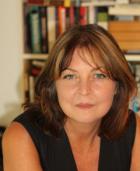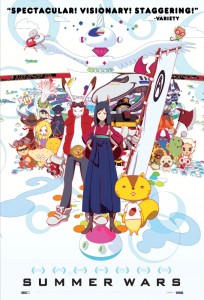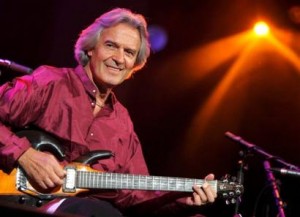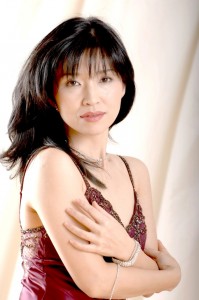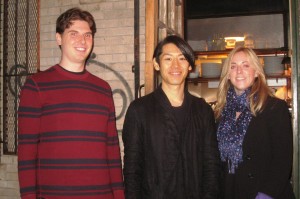US media coverage of Japan’s economy overly negative?
There’s an excellent letter in the New York Times from Yasuhisa Kawamura of the Consulate General of Japan in New York in which he makes the case that U.S. media coverage of Japan’s economy has been overly negative. The gist of it is, Sure, times are tough in Japan. But they’re also tough in the U.S. and elsewhere. Nonetheless, there’s still a vibrant economy and significant innovation and other activity going on in Japan.
If any JETs or JET alums or Friends of JET would like to weigh in on this, it would be nice to hear some first-hand perspectives from people who are currently living in Japan or travel back and forth frequently.
Here’s a link to the letter: http://www.nytimes.com/2010/11/03/opinion/lweb03japan.html?scp=1&sq=kawamura&st=cse
And here’s the full text of the letter:
To the Editor:
By oversimplifying and exaggerating certain socioeconomic aspects at the expense of the broader picture, “Japan Goes From Dynamic to Disheartened” (“The Great Deflation” series, front page, Oct. 17) depicts some interesting “trees” but misses the “forest” that is Japan today.
Unfortunately, the story’s few anecdotal views do not accurately reflect a diverse nation of 120 million people and one of the world’s largest economies. During these times of severe economic challenges around the globe, similarly pessimistic views about the future could surely be found in almost any Group of 8 country.
Far from being an “afterthought” weary of its global role, Japan remains committed to active leadership in the world. This international outlook is best reflected in Japan’s policies and the vibrancy of its young people. Take Afghanistan, where a $5 billion aid commitment supports 96,000 local policemen, has built 650 schools and has provided polio and other essential vaccines to 47 million children.
Additionally, Japanese youngsters, supported by the affluence of the past decades, enjoy diverse career choices, and, according to recent surveys, the most desirable job for Japanese university graduates remains working in the field of international trade.
Yasuhisa Kawamura
Director, Japan Information Center
Consulate General of Japan
New York, Oct. 29, 2010
Justin’s Japan: Interview with ‘Hiroshima in the Morning’ Author Rahna Reiko Rizzuto
By JQ magazine’s Justin Tedaldi (CIR Kobe-shi, 2001-02) for Examiner.com. Visit his NY Japanese Culture page here to subscribe for free alerts on newly published stories.
In June 2001, award-winning Japanese American author Rahna Reiko Rizzuto went to Hiroshima on a six-month fellowship to interview the hibakusha, or remaining survivors of the atomic bomb. Three months later, the September 11 attacks on the U.S. changed everything, from the recollections of the survivors to Rizzuto’s own relationship with her family back in America, including her husband and two young sons in New York.
The result was Hiroshima in the Morning, a memoir released last fall in which the author weaves these threads into a deeply personal story of awakening about how we choose our identities, how we view history, and how we use memory as a story we tell ourselves to explain who we are. I caught up with Rizzuto to discuss her emotional journey and impressions of Japan.
What was the most interesting thing about talking with the atomic bomb survivors in Hiroshima?
I went to Hiroshima initially because I knew so little—almost nothing—about the atomic bomb and its effects. I arrived more than 55 years after the bombing, so I expected memories to be a little hazy. When I first arrived, I met people who were very committed to telling their stories in the interest of peace. They wanted to testify about the power of the atomic bomb and the devastation of war in general in hopes that there would be no more war. That would make their sacrifices worth it.
I was there to write a novel, though, not a factual piece, so what I was looking for was textures and details about what it was like to live in those times, and how one survived war. So what I was getting was not exactly what I was looking for. Their stories were very complete and rehearsed. What happened then, though, was after three months of listening to these testimonies, the September 11th attacks happened within sight of my Brooklyn home. The world changed. And so did their stories.
In hindsight, how different did the interview project turn out because of 9/11?
I don’t think anyone can underestimate the effects of those attacks. They reverberated immediately, all the way to Japan, and we all suddenly felt the world was not safe. We were not safe. And if we weren’t safe, there was no peace, and if there was no peace, the hibakusha realized, then their sacrifice was for nothing.
Almost immediately, this destabilization affected their stories. They began to feel more, and to remember more. Moments and people they had blocked out came back to them. They remembered heat, and color and sound. And they remembered what it felt like to go back to their homes and find their mothers’ bones.
Which of the testimonials affected you the most? Why?
The most unbearable stories were often about children. Children who died; children who tried to save their brothers or parents; children who cremated their parents, at age six, because that was what their parents would have wanted. In the months after 9/11, though, something happened which was very moving and powerful. A number of people came to me to tell their stories. Before then, I had been finding my own interviewees with the help of my translators, but after September 11th, I found out that many people actually knew I was there, listening, and they sought me out because they needed a witness. They needed a safe place to relive, and purge, their memories. And then, it wasn’t just the sad moments. It was also the happy memories of life before, and their family members before. They needed to share those, too, and they gave them to me so their loved ones would not fade away.
Click here for the rest of the interview.
James Kennedy reviews “Pluto killer” book for Wall Street Journal
James Kennedy (Nara-ken, 2004-06), author of the acclaimed young adult novel The Order of Odd-Fish, has a great review in the Wall Street Journal of a sugoku omoshiroi book titled, How I Killed Pluto, And Why It Had It Coming by professor of astronomy Mike Brown.
Here’s the link: http://online.wsj.com/article/SB10001424052748704243904575630683559145518.html#articleTabs%3Darticle
Op-ed on U.S. energy policy by JET alum
![]() JET alums are indeed everywhere. Here’s a recent opinion article by New York-based alum Sam Lederer (Shizuoka-ken, 2005-07), a Contributor at Americans for Energy Leadership, on potential directions in U.S. energy policy for the “lame-duck” session of the U.S. Congress.
JET alums are indeed everywhere. Here’s a recent opinion article by New York-based alum Sam Lederer (Shizuoka-ken, 2005-07), a Contributor at Americans for Energy Leadership, on potential directions in U.S. energy policy for the “lame-duck” session of the U.S. Congress.
CLICK HERE to read some of Sam’s other writings on Japanese energy and environmental policy.
Sam can be reached via his LinkedIn profile and can be followed via Twitter @samlederer
Justin’s Japan: ‘Summer Wars’ Anime Aims for Oscar (Film Review)
By JQ magazine’s Justin Tedaldi (CIR Kobe-shi, 2001-02) for Examiner.com. Visit his NY Japanese Culture page here to subscribe for free alerts on newly published stories.
The opening scene of Mamoru Hosoda’s animated film Summer Wars transports us to the virtual world of OZ, a place where hundreds of millions of users chat, shop and play via customized avatars in a breathtakingly trippy space that owes much to contemporary Japanese pop artist Takashi Murakami and Mamoru Oshii’s Ghost in the Shell movies. But it’s in rural Nagano where most of Summer Wars occurs, and this setting gives it a heart in a world that’s becoming increasingly addicted to online social networks and mobile devices.
The film enjoyed a sold-out reception of its English language premiere at Asia Society yesterday as part of distributor GKIDS’ annual New York International Children’s Film Festival. Fueled by Internet buzz and rapturous word of mouth upon its initial release in Japan last year, the film won a clutch of awards and is an official entry for Best Animated Feature at the 2011 Academy Awards.
The plot: teenage OZ moderator Kenji (voiced by Michael Sinterniklaas) agrees to a “job” escorting his popular schoolmate Natsuki (Brina Palencia) to her great-grandmother’s upcoming 90th birthday celebration at the family’s enormous estate in Ueda. The catch: he’s asked by his secret crush to pose as her fiancé, which hits complications as her crazed extended family enters the picture. To make matters worse, Kenji unwittingly triggers a malicious AI program called Love Machine that threatens not just the existence of OZ, but the rest of the real world with its interdependence on technology. It’s up to the boy—a girl-phobic math prodigy—to gain new confidence in himself in order to right OZ and win his dream girl’s heart.
Click here for the rest of the review.
WIT Life #137: Tokyo Sky Tree
WITLife is a periodic series written by professional Writer/Interpreter/Translator Stacy Smith (Kumamoto-ken CIR, 2000-03). She starts her day by watching Fujisankei’s newscast in Japanese, and here she shares some of the interesting tidbits and trends together with her own observations.
Very interesting article in yesterday’s NYT about how efforts are being made to reduce the presence of yakuza in various business transactions. The story focuses on the recent construction project of Tokyo Sky Tree, a communications tower. This is a huge change as traditionally yakuza have been an integral part of this industry, often seeking “protection money” from developers. Developers might also call on the yakuza to give an extra push to people unwilling to give up their land. I liked Jake Adelstein‘s quote calling the yakuza “Goldman Sachs with guns.” Check out the adjoining picture to see a comparison between Tokyo Tower and the “new Tokyo Tower,” what Sky Tree was called before decided on its official name. Other candidates were Tokyo Edo Tower, Mirai (Future) Tree, Yume Miyagura (Dreamwatching Tower), Rising East Tower and Rising Tower. It is due to be completed next year.
Interview with Guitar God John McLaughlin
By JQ magazine’s Justin Tedaldi (CIR Kobe-shi, 2001-02) for Examiner.com. Visit his NY Japanese Culture page here to subscribe for free alerts on newly published stories.
Whether you call it electric jazz, fusion, or just good old music, John McLaughlin is the forefather of this style on the six string. From his contributions on classic albums by Miles Davis starting with the landmark In a Silent Way in 1969 to his own work with the massively influential Mahavishnu Orchestra and as a solo artist, McLaughlin is a legend who has continued to record with no signs of slowing down.
His 2009 collaboration with Chick Corea, Five Peace Band, won the Grammy Award for Best Jazz Instrumental Album earlier this year, and in April McLaughlin then released his new disc with the 4th Dimension, To the One (Abstract Logix). Following a concert at New York’s Town Hall last weekend, the artist graciously took the time to answer some questions.
Tell us about your history with Japan. What attracted you most to the culture?
I’ve been studying the cultures of Asia for many years, and I’m very attracted to the culture of Japan, in particular to the impact Zen has had on the Japanese mind and spirit. That said, any in depth study of Zen will bring you to China and the culture of Chan, the forerunner of Zen. In my opinion, there is one singular problem with religions in general: they are exclusive. To me, this exclusivity is not right. Zen and Chan’s “ways” of discovery are non-exclusive. They speak about the reality of everyone having Buddha nature, and the potential of realizing it. This is the aspect of Zen and Chan that appeals to me strongly: the non-discrimination and inclusivity of everyone.
Are there any Japanese musicians of whom you’re a fan? What other kinds of Japanese performing arts do you enjoy?
I am less of a fan of Japanese music than I am to the poetry of haiku strangely enough, though I do enjoy the koto and shakuhachi music. The Zen calligraphy is something for which I have a great admiration.
Why do you think the Japanese possess such a great interest in jazz?
For sure the answer lies in the culture of the Japanese mind. Perhaps because the spontaneity of jazz appeals to their innate sense of honesty. In improvisation, jazz or otherwise, there’s no room to lie.
Click here to read the rest of the interview.
Interview with Jazz Musician Keiko Matsui
By JQ magazine’s Justin Tedaldi (CIR Kobe-shi, 2001-02) for Examiner.com. Visit his NY Japanese Culture page here to subscribe for free alerts on newly published stories.
Contemporary jazz icon Keiko Matsui began playing piano at the age of five. With sales of over 1.2 million units in the U.S. and sold-out appearances at concert halls across the world, she is one of the most recognized artists in the genre.
In addition to being the first Japanese artist to top Billboard’s contemporary jazz chart, she actively supports a range of charities, including the Y-Me Breast Cancer Organization. United Nations World Food Programme’s efforts in Africa, and California for A3M’s charity for the National Marrow Donor Program.
Matsui is now putting the final touches on her latest album, due early 2011 with Shanachie Records. I spoke with her prior to her debut three-night stand happening next week at New York’s venerable Blue Note Jazz Club.
Congratulations on your very first show at New York’s Blue Note. How do you feel about playing there and what do you expect?
Of course in New York, Blue Note is a legendary place, and I’m very happy to be there. At the same time, I have toured in many different countries, and I always feel very fortunate at the concerts to feel that music connects us beyond the culture, history, country, everything. So, I really feel that this experience at Blue Note will be very special.
When did you first come to the U.S.?
In the early ’80s.
What did you do there?
At that time, I was invited to Los Angeles by Yamaha for a special recording. I was also a student, and had the opportunity to make a sample album with Vinnie Colaiuta and Nathan East. That was my first visit to the U.S., and also my first recording there. I invited Vinnie to record on my new album, so I’m glad to see him again.
What were your memories of that experience? Did you have any culture shock?
I only had one week there, so of course I didn’t know much about the music scene in the U.S., but I was so entranced by Nathan and Vinnie’s playing. It was great creating music together with great musicians, but at that time they were so open. Maybe this is a cultural difference, because Japanese language is based on politeness and different words depending on who you talk to, but English doesn’t have that. So, Japanese people speak really strictly, I felt.
You’ve had a successful career for a long time. Why have you decided to play Blue Note now?
That’s true. For me, that’s something I’m kind of questioning myself, too. [laughs]
Click here to read the rest of the interview.
Interview with Competitive Eater Takeru Kobayashi
By JQ magazine’s Justin Tedaldi (CIR Kobe-shi, 2001-02) for Examiner.com. Visit his NY Japanese Culture page here to subscribe for free alerts on newly published stories.
Takeru “The Tsunami” Kobayashi is a three-time Guinness World Record holder for competitive eating. He burst on the American scene in 2001 at Coney Island’s annual Nathan’s Hot Dog Eating Contest by downing 50 dogs in 12 minutes, doubling the previous record. Kobayashi went on to win the contest six consecutive times while shattering other gastronomic records around the world.
After a shocking arrest and subsequent dismissal of charges in July at this year’s Nathan’s event, Kobayashi returned to the stage last night at the Japan Arts Matsuri in Brooklyn for another challenge: to become the world’s fastest 12-inch pizza eater. While he fell less than 20 seconds short of the 1:45 record (saying afterward that the pie was softer than he anticipated), there was no doubt among the crowd that the champ will give it another try in the near future. Hours before taking the stage, I spoke with Kobayashi through his interpreter Emiko Watanabe for this rare English language interview.
What kind of training does one have to do to be the world’s fastest pizza eater?
I had to practice how to use a knife and fork, because I have to use it for this challenge. That was the main thing.
That’s interesting. Most people don’t use a knife and fork to eat a pizza.
It would be much easier if I was allowed to use my hands instead. So it’s going to be a little harder.
What’s your favorite kind of pizza?
Pizza Margherita.
How are things after July 4th? Do you find that you’re more popular and recognized in New York from people on the street?
[laughs] I think so; I feel that I’m more recognized than before. I was famous before as a six-time champion [at the Nathan’s contest], but after Independence Day this year, people think I’m more interesting and have humor, so people notice me a lot more than before.
Where do you live in New York?
Manhattan.
Many celebrities in America are known for their talent, but personality is also important. Are you making more efforts to do things like learn English to become a bigger celebrity here?
I started going to an English school last month.
What kinds of things do your fans ask when they recognize you?
They don’t really ask anything, but they do ask to take a picture with me.
Any memorable encounters?
I met this fan who didn’t recognize me at first. She was an African American lady, and when she first spoke to me, she just thought I was a cool or cute Japanese guy. We talked, but then she recognized who I was, saying, “Oh my God! Oh my God!” It turns out that she was scrapbooking all of my articles from Independence Day, and the reason she did that is because she thought I was cute. When she realized that I was the same person, she went out of control screaming.
Click here to read the rest of the interview.
Kobayashi Headlines New York’s Annual Japan Arts Matsuri
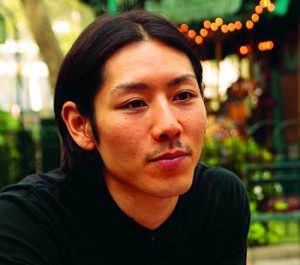
Eating champ Takeru Kobayashi competes at JAM 2010 Nov. 13. (Courtesy of Rei Miura/NPO American Dream Japanese Network)
By JQ magazine’s Justin Tedaldi (CIR Kobe-shi, 2001-02) for Examiner.com. Visit his NY Japanese Culture page here to subscribe for free alerts on newly published stories.
“Ultimate Food Fighter” Takeru Kobayashi returns to eat another day to break a new Guinness World Record as the special guest of the 8th Annual Amnet New York Japan Arts Matsuri this weekend at Java Street Hall in Brooklyn. While traditional Japanese matsuri, or festivals, occur in the summer, this year’s edition of JAM will sport some of today’s best, most energetic Japanese performing artists working in New York. With the entire event will be aired live worldwide via Ustream, JAM will beat the drum for Japan and Japanese culture through art and entertainment. New Yorkers know Kobayashi primarily as the six-time winner of the Nathan’s International July 4 Hot Dog Eating Contest, but on Saturday he will attempt to break the Guinness world record for the quickest time for downing a 12-inch pizza.
Sunday, Japanese singer-songwriter Senri Oe will perform piano with his own jazz trio, featuring Semar on bass and Joe Abams on drums. This year, JAM expects to draw a two-day total of over 800 ardent fans of Japanese arts. Over the two days, the popular “Talent Night” will feature nearly two dozen up-and-coming singers, dancers, musicians and other performers who successfully made the cut before JAM’s judges. Brooklyn-based Japanese drum group Taiko Masala is one of the performers poised to bring Japan a bit closer to the borough, and an audience participation dance demonstration by Yosakoi Dance Project 10tecomai (featuring JETAANY member/JetWit contributor Kirsten Phillips) is guaranteed to raise the roof.
For the complete story, click here.
Talking Bra (Yes, a Talking Bra) to Stimulate Japanese Tourism
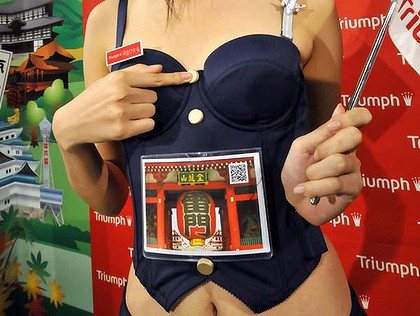
"Welcome to Japan": Electronic buttons running down the centre of the garment triggers audio greetings in English, Chinese and Korean. (AFP)
Courtesy of the Sydney Morning Herald.
As Japan hosts a Asia-Pacific summit this week, a women’s underwear maker on Wednesday unveiled a bra that is meant to lift spirits as well as bust lines and support the country’s tourism sector.
Triumph Japan showcased its bustier-style “Welcome to Japan! Bra” that it said was inspired by a tour guide’s uniform, features a display for images of sightseeing spots and can greet visitors in three languages.
A row of three electronic push buttons running down the centre of the garment triggers audio greetings in English, Chinese and Korean.
“Furthermore, tour guide flags are inserted on each side of the bra,” the company said. “When not used to guide tourists, the flags act as side stays, providing good support and creating an attractive bust line.”
Read the complete story (with video!!) here.
Don’t believe the hype
A recent post on InsideJapan News Network titled “Japan Plans US Teacher Training Scheme” cites a Daily Yomiuri article about a new proposed project to send Japanese teachers to the U.S. for two years of training. The Yomiuri article suggests that if this new project were to go forward, it would mean the end of the JET Programme.
However, after checking with several well-versed sources both in and out of the Japanese government, it sounds like the article’s analysis is inaccurate. Apparently, it would most likely be complementary program (if it even happens) and would not mean the end of the JET Programme.
To paraphrase one source, it wouldn’t make sense for President Obama to back a plan that would reduce the number of jobs for Americans.
Return of the Samurai
Thanks to JET alum Margie Banin (who works as an “Ex-pat Coach”) for sharing a nice NY Times article titled “Return of the Samurai” which comments on the 150th anniversary of the first Samurai delegation to visit the U.S. in 1860.
Among other interesting tidbits, there was apparently almost a scandal when several of members of the Japanese delegation were found naked together in their hotel bathtub.
JET alum Foster Klug named AP News Editor in Seoul
Thanks to Nagasaki-ken JET alum Christy Jones for passing along this item from the New York Times about fellow Nagasaki JET alum Foster Klug:
According to the article in the New York Times:
Foster Klug, a reporter who has covered U.S.-Asia relations for The Associated Press in Washington, has been named the AP’s news editor in Seoul, South Korea.
…….
Klug was the first U.S.-Asian affairs reporter on AP’s North America Desk, which is responsible for U.S. news coverage targeted for audiences outside the United States. He has written on an array of issues, including U.S. sanctions against North Korea, Washington’s currency dispute with China and U.S. arms sales to Taiwan.
…….
Previously, he lived for three years in rural Nagasaki, Japan, where he taught English and coached basketball at a junior high school. He is a graduate of Colby College in Waterville, Maine.
Here’s the link to the full article: http://www.nytimes.com/aponline/2010/11/05/us/AP-US-AP-Appointments.html?hp
Hokkaido JET Annual Musical Production Tradition Continues
Snow, Sea and Song
Hokkaido’s hills are alive with the sound of music, thanks to the efforts of its ALTs
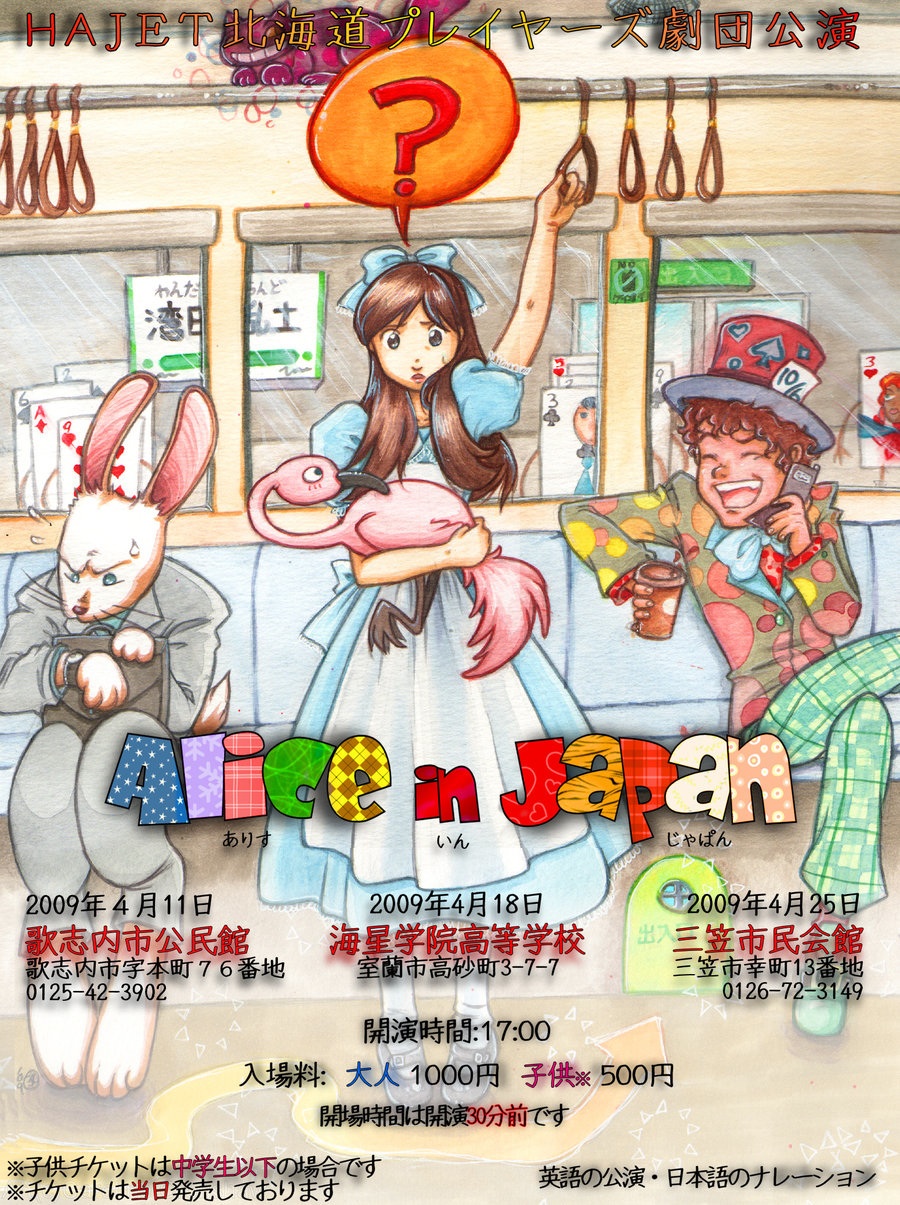 By Caroline Cronshaw (Hokkaido, 2006-09) – Caroline is an amateur illustrator and instructor at the University New Brunswick in Saint John, New Brunswick, Canada. She has painted and designed posters for the HAJET Hokkaido Players’ productions for the past four years, and is currently working 2011’s poster as of this article. Her work can be seen at http://carrie-ko.deviantart.com.
By Caroline Cronshaw (Hokkaido, 2006-09) – Caroline is an amateur illustrator and instructor at the University New Brunswick in Saint John, New Brunswick, Canada. She has painted and designed posters for the HAJET Hokkaido Players’ productions for the past four years, and is currently working 2011’s poster as of this article. Her work can be seen at http://carrie-ko.deviantart.com.
Whether they choose to go to Hokkaido or not, several hundred new JET participants, some of whom have never seen a snowflake before in their lives, come to live on the northernmost island in the Japanese archipelago each year.
Hokkaido, with its vast tracts of wilderness and ghostly former coal mining towns, can cause even the most steadfast and Canadian of JETs to surrender to homesickness and cabin fever during its long and snowy winters. It’s those same cold and white expanses that probably inspired the Ainu peoples to come up with place names like Shiretoko – ‘the ends of the earth’. Indeed, it’s not easy being a homesick alien living in a half-buried BOE-owned hut in midwinter.
Thankfully, however, the ALTs of Hokkaido have come up with an unusual cure for the winter blues: musical theatre.
Since the mid-1990s, denizens of many Hokkaido communities have been witness to a mysterious caravan of vans and cars rumbling into town on a Friday night and parking in front of a local community centre or temple. These vehicles, laden with wooden planks and props, belong to none other than the members of the HAJET Hokkaido Players, an amateur theatre troupe comprised of JET participants from across the island. While some members do have experience in acting or stage production, there is no requirement except dedication and the desire to help bring international understanding to the people of Hokkaido. The troupe is partly administered by HAJET, the Hokkaido AJET chapter, and is entirely non-profit. If there is money left over or gained from performances, most of it is used to sponsor the Hokkaido English Challenge, an annual non-profit English-language summer camp program also organized by HAJET. The rest of the profit is saved for next year’s show.
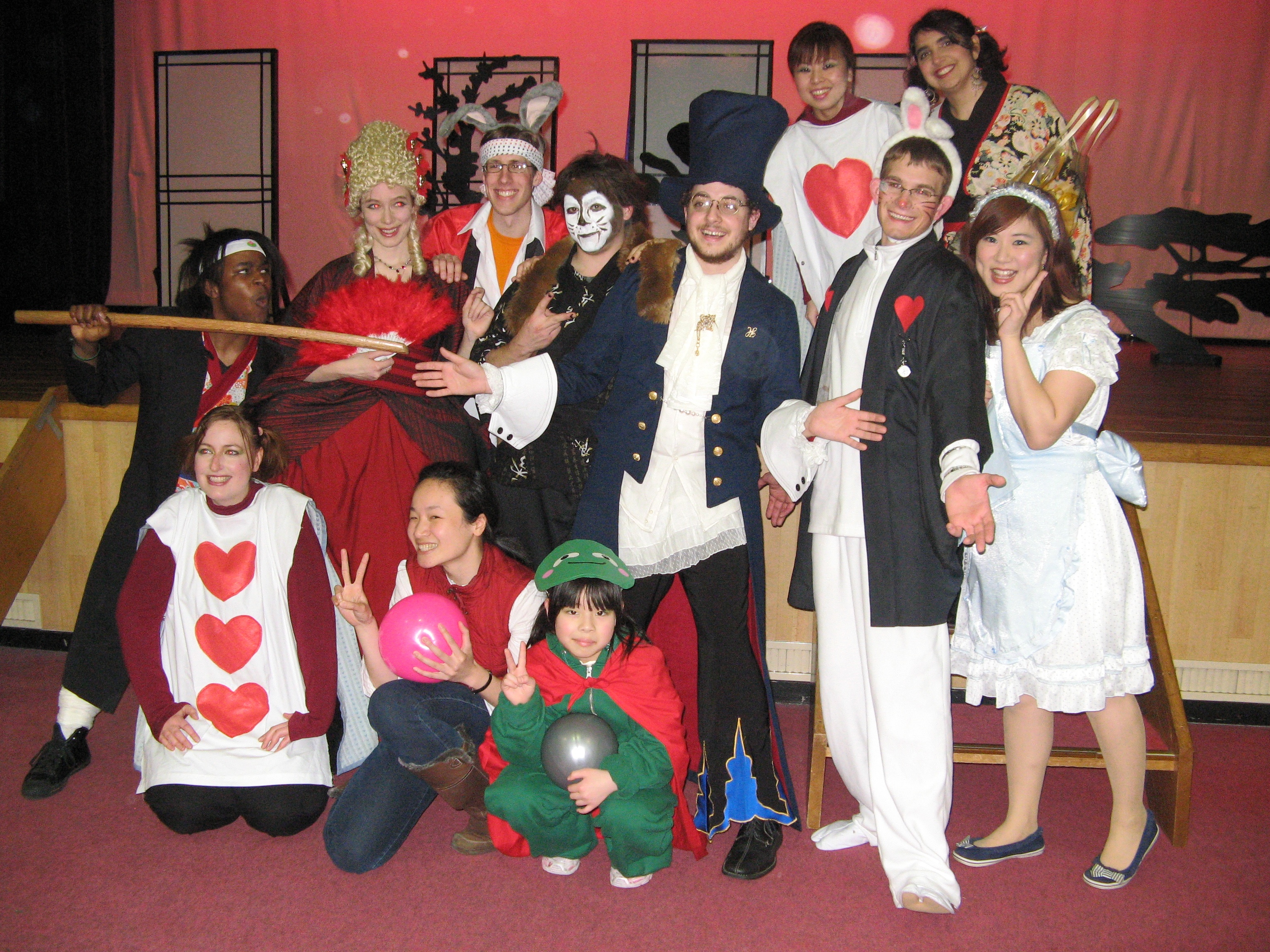 Among the various Broadway staples the HAJET Hokkaido Players have performed are such familiar titles as West Side Story, Annie, Peter Pan, Oklahoma!, and Guys and Dolls. They also on occasion perform original works, such as 2009’s Alice in Japan, originally written by ALTs in Niigata. This year’s production will be an original play based on The Jungle Book (the Kipling novel, not the Disney adaptation). According to the Players’ current director, Melissa Golden, the production will incorporate elements of Bollywood cinema and traditional Indian costume, as well as make use of Lion King-style animal masks.
Among the various Broadway staples the HAJET Hokkaido Players have performed are such familiar titles as West Side Story, Annie, Peter Pan, Oklahoma!, and Guys and Dolls. They also on occasion perform original works, such as 2009’s Alice in Japan, originally written by ALTs in Niigata. This year’s production will be an original play based on The Jungle Book (the Kipling novel, not the Disney adaptation). According to the Players’ current director, Melissa Golden, the production will incorporate elements of Bollywood cinema and traditional Indian costume, as well as make use of Lion King-style animal masks.
The Players start planning their productions early in the year, around the end of August when the newbies first arrive from overseas. Recruitment is usually done around early to mid September during the various welcome parties (with an island that big, you’d need to have several parties), and the first rehearsal is typically scheduled for later in the month or in early October. From that point onward, it’s full speed ahead, and anyone who can’t commit will be left in the dust. Despite the subject, it’s serious business.
Depending on the show and the wishes of the director, the English script is augmented with either lines in Japanese, framed scene-by-scene with Japanese narration, or both. This is to help audience members without English proficiency or previous knowledge of the play to understand what is going on. The Players also do their research in more pop culture-related subjects Read More

